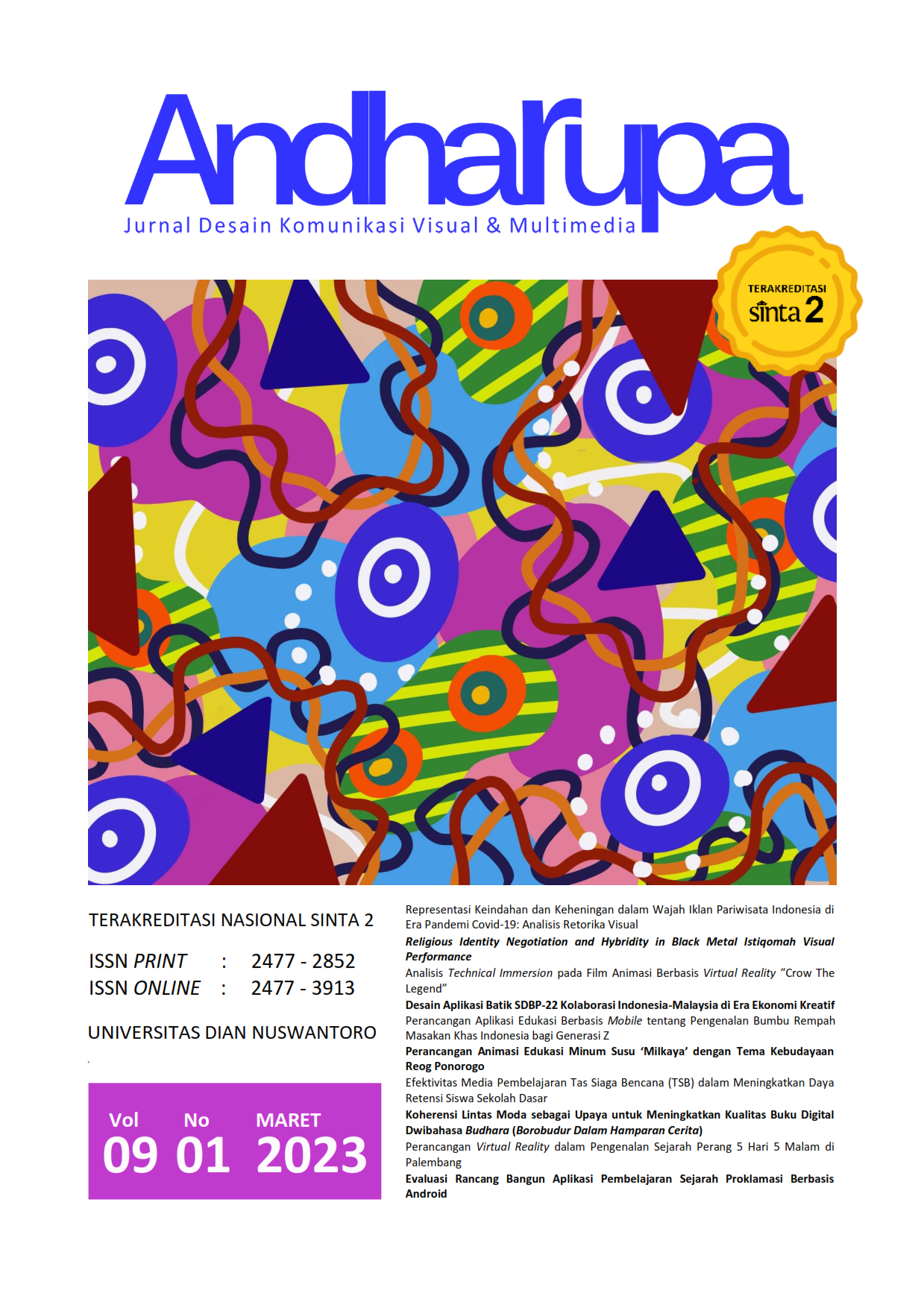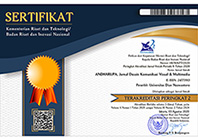Analisis Technical Immersion pada Film Animasi Berbasis Virtual Reality “Crow The Legend”
DOI:
https://doi.org/10.33633/andharupa.v9i01.5258Abstract
Abstrak Film konvensional menggunakan aspek cerita dan aspek sinematografi untuk membangun penceritaan visual dalam film. Pada film VR, terdapat pengalaman imersif yang dapat mengurangi fokus penonton pada konten cerita. Film animasi Crow: The Legend (2018) merupakan animasi yang memiliki penceritaan visual yang dinilai berhasil menyeimbangkan sisi imersif dan storytelling, salah satunya karena memenangkan penghargaan di kategori Immersive Storytelling Narrative VR di My Hero Film Festival 2018. Penelitian ini bertujuan untuk mengkaji bagaimana aspek sinematografi yang biasa digunakan dalam film konvensional, digunakan untuk penceritaan visual dalam film animasi VR Crow: The Legend. Metode penelitian yang digunakan adalah kualitatif deskriptif dengan analisis data menggunakan teori aspek sinematografi dan aspek imersif. Analisis dilakukan dengan menggunakan teori Technical Immersion (Elmenzeny, 2018). Peneliti menemukan bahwa aspek sinematografi yang dibagi menjadi; sudut pandang, continuity, cutting, komposisi dan tata cahaya yang disesuaikan dengan aspek Technical Immersion dapat diadaptasi untuk penggunaan dalam film VR. Kata kunci: animasi, immersion, sinematografi, virtual reality AbstractConventional films use story and cinematographic aspects to build visual storytelling in films. In VR movies, there is an immersive experience that can reduce the audience's focus on the story content. The animated film Crow: The Legend (2018) is an animation that has a visual storytelling that is considered successful in balancing the immersive and storytelling sides, one of which is because it won an award in the Immersive Storytelling Narrative VR category at My Hero Film Festival 2018. This study aims to examine how the cinematographic aspects which are commonly used in conventional films are used for visual storytelling in the animated film VR Crow: The Legend. The research method used is descriptive qualitative with data analysis using the theory of cinematographic aspects and immersive aspects. The analysis was carried out using the Technical Immersion theory (Elmenzeny,2018). The researcher found that cinematography aspects which were divided into point of view, continuity, cutting, composition and lighting adapted to Technical Immersion aspects could be adapted for use in VR films. Keywords: animation, cinematography, immersion, virtual realityReferences
Brown, B. (2016). Cinematography Theory & Practice: Imagemaking for Cinematographers & Directors. New York: Routledge.
Caldwell, C. (2017). Story Structure and Development: A Guide for Animators, VFX Artist, Game Designers, and Virtual Reality. Boca Raton: Taylor & Francis Group.
Caputo, T. C. (2003). Visual Storytelling: The Art and technique. New York: Watson-Guptill Publications.
Cutler, L., Darnell, E., Dirksen, N., Hutchinson, M., Peterson, S., Schiewe, R., & Wang, W. (2019). Making you matter: Creating interactive VR narratives through experimentation and learning. Proceedings - DigiPro 2019: ACM Digital Production Symposium.
Danisworo, D (2002). Structure of Visual Storytelling and Graphic Design. New York: Rochester Institute of Technology.
Eisner, W. (1996). Graphic Storytelling and Visual Narrative. Tamarac: Poorhouse Press.
Elmezeny, A., Edenhofer, N., & Wimmer, J. (2018). Immersive Storytelling in 360-Degree Videos: An Analysis of Interplay Between Narrative and Technical Immersion. Journal of Virtual World Research, 11(1).
Glebas, F. (2009). Directing the Story: Professional Storytelling and Storyboarding Techniques for Live Action and Animation. USA: Elsevier.
Katatikarn, J., & Tanzillo, M. (2017). Lighting for Animation. Boca Raton: Taylor & Francis.
Mascelli, J. V. (1998). The Five C’s of Cinematography: Motion Picture Filming Techniques. Los Angeles: Silman-James Press.
Tricart, C. (2018). Virtual Reality Filmmaking: Techniques & Best Practice for VR Filmmakers. New York: Routledge.
Downloads
Published
Issue
Section
License
Authors who publish with this journal agree to the following terms:
- Authors retain copyright and grant the journal right of first publication with the work simultaneously licensed under a Creative Commons Attribution License that allows others to share the work with an acknowledgment of the work's authorship and initial publication in this journal.
- Authors are able to enter into separate, additional contractual arrangements for the non-exclusive distribution of the journal's published version of the work (e.g., post it to an institutional repository or publish it in a book), with an acknowledgment of its initial publication in this journal.
- Authors are permitted and encouraged to post their work online (e.g., in institutional repositories or on their website) prior to and during the submission process, as it can lead to productive exchanges, as well as earlier and greater citation of published work (See The Effect of Open Access).















